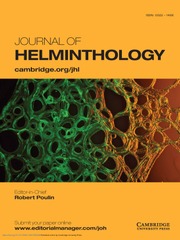No CrossRef data available.
Article contents
Taxonomy and molecular phylogeny of Urocleidoides spp. (Monopisthocotyla: Dactylogyridae): Four new species and cophylogenetic patterns in a clade of species parasitizing Characiformes hosts
Published online by Cambridge University Press: 29 August 2025
Abstract

Historical reconstruction studies are important for understanding the evolutionary mechanisms associated with different parasite-host systems. Platyhelminths of the classes Monopisthocotyla and Polyopisthocotyla (formerly Monogenoidea or Monogenea) have proven to be excellent models for historical reconstruction studies due to their exceptional parasite specificity, suggesting that cospeciation events are the main pattern observed in these parasite-host systems (i.e., codivergence). However, recent studies indicate that not only cospeciation but also duplication, host-switch, and loss (extinction) events are necessary to explain the historical association patterns between monopisthocotylan lineages and their hosts. In the present study, we describe four new species of Urocleidoides parasitizing the gills of Characiformes and Gymnotiformes hosts from the coastal drainages of the eastern Brazilian Amazon. We also used a cophylogenetic approach to investigate the coevolutionary relationships between Urocleidoides species and their characiform hosts to determine which coevolutionary events are acting to diversify the parasites. To achieve our goal, we used Jane to estimate coevolutionary scenarios and PACo to assess the cophylogenetic signal and phylogenetic congruence between parasite and host phylogenies. The comparison between the parasite phylogeny, based on partial sequences of the 28S rDNA gene, and the host phylogeny, inferred from concatenated partial sequences of the RAG1, RAG2, Cytb, and COI genes, revealed a high degree of topological congruence between them. Our results indicate a mixed evolutionary scenario, where cospeciation played an important role but was accompanied by significant loss events, failure to diverge and host-switch, suggesting that the diversification of Urocleidoides in Characiformes did not occur in a restricted way but with episodes of adaptation and possible colonization of new hosts over time.
Information
- Type
- Research Paper
- Information
- Copyright
- © The Author(s), 2025. Published by Cambridge University Press

